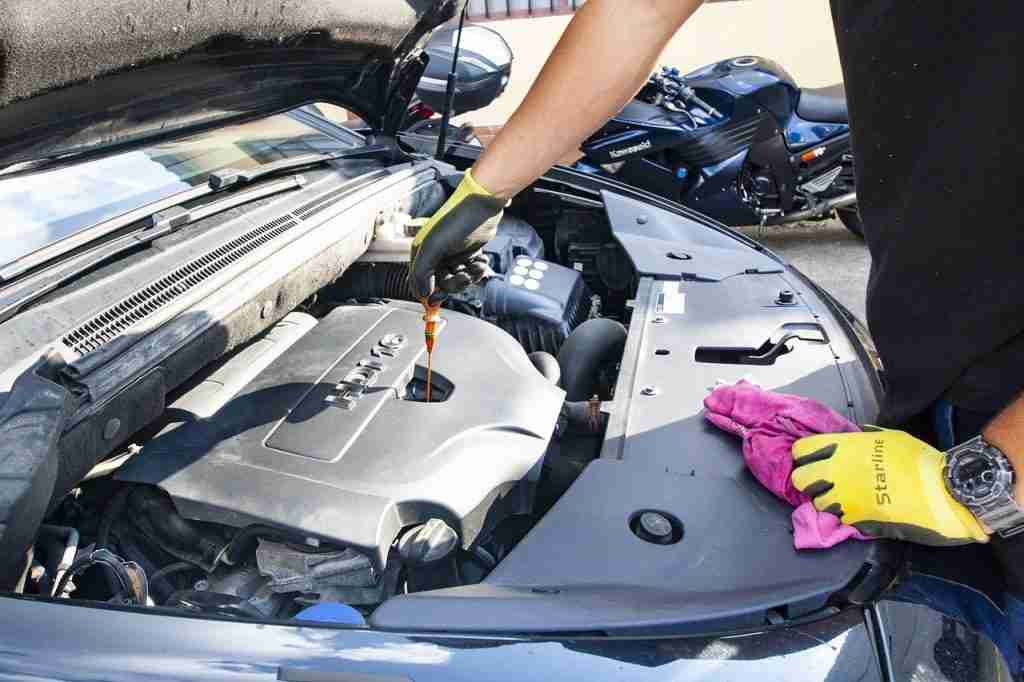What Does Oil Do in a Car?

What Does Oil Do in a Car?
If you don’t want to end up stranded somewhere, it is critical to take care of your car’s engine. The easiest way to do this is by having your oil changed regularly. If you don’t do this, you are asking for engine failure. The good news is oil changes are fairly inexpensive and quick. If you wish, you can even change it yourself. In this article, we will explain everything you need to know about engine oil.

Basically, engine oil lubricates the moving parts in your car’s engine. It does this by cycling through your vehicle’s oil system, made of the following:
- Oil sump
- Oil filter
- Oil pump
- Oil galleries
Below you will find the 5 functions of engine oil.
5 Functions of Engine Oil
There are five things that motor oil does for your engine. They are as follows:
Lubricates the Engine
As the oil is pumped into the engine, it lubricates the moving parts leaving a slippery film on them. This film decreases friction by minimizing contact between components. This helps to reduce wear and tear of engine parts increasing the life of the engine.
Removes Contaminants
When an engine runs, it creates contaminants and byproducts which can negatively impact to your engine. As the oil circulates it collects those contaminants and keeps them from damaging the engine components. This is because of the dispersants that are added to the oil when it is produced giving it the ability to keep the engine clean.
Maintains Engine Temperature
When you start your engine, it begins to heat up. Engine oil remove this heat and takes it into the oil sump or oil cooler. engine oil is actually responsible for around 40% of the cooling process within an engine. Additionally, it keeps the temperatures constant as it flows over surfaces.
Prevents Corrosion
When an engine is performing properly, the oil creates a barrier between engine parts to protect them against corrosion. Modern oils contain additives that chemically neutralize any corrosion.
Optimizes Performance
It is difficult to get metal surface is perfectly smooth especially when moving parts are involved. In order to prevent loss of engine performance, the oil seals the spaces between the piston and cylinder to optimize overall performance.
How Does an Oil Change Help?
As mentioned previously oil changes are critical for the health of your engine. However, do you wonder why it’s so important?
In the past, drivers needed to change their oil every 3000 miles. However, modern oil is more advanced, and we no longer have to do that. The role of oil has not changed very much. It still performs the same functions, but more efficiently. If you do not have regular oil changes, the oil will thicken 28 are like thickness and becomes engine sludge.
This sledge we’ll stick to engine parts instead of lubricating them. It blocks the oil passages which starves the engine of oil. The heat from the engine hardens engine sledge which results in major issues for valves, pistons, and fuel injectors.
If you ignore engine sludge, you could do significant damage to your engine. The best way to prevent engine sledge from developing is to have regular oil changes.
What if I Don’t Get My Oil Changed?
If you’re short on money, you might be tempted to skip the oil change. However, this could end up being more costly in the end.

One major issue will be debris and contaminants being deposited in your engine. The oil is what keeps the engine clean by picking up anything that should not be there and taking it to the oil filter. When the filter gets clogged, dirty oil is cycled back through the engine.
Contaminants build up in the oil and it becomes abrasive, wearing down engine parts and making the engine work harder to move the sludge around.
How Often Should Engine Oil be Changed?
End the past, it was recommended to change your oil every 3000 miles. However, due to research and technology advancements, this rule no longer applies. You need to consult with your owner’s manual to find out how often to change your oil. If you’re not sure, it’s better to get it changed more often than to delay it.
Can I Add Oil Instead of Changing It?
While it is true that you can add new oil to old, it should only be done in the case of an emergency. That is, your car is low on oil, and you are driving straight home and will follow up with an oil change.
When you add new oil to the old, the old oil doesn’t just disappear. Instead, it waters down the new oil and decreases its ability to perform. The oil will be thick and gritty which is not ideal for the health of an engine.
Types of Engine Oil
There are four types of engine oil. They are listed below:
- Full Synthetic
- Synthetic Blend
- High Mileage
- Conventional
Motor Oil Grades Explained
The viscosity rating is the most important characteristic of oil. This is indicated by the series of numbers and letters that are on the bottle. For example, 10W-40.
Viscosity measures the movement of a fluid. It is broken down into two key characteristics:
- Kinematic viscosity
- Dynamic viscosity
The first number refers to resistance to flow when you cold start your engine. The second number refers to the resistance to flow the oil has at normal operating temperature.
Choosing the Right Oil for Your Vehicle
Now that you are aware that there are different engine oils, you might wonder if you should switch to a high performing oil. However, before you switch you need to check your owner’s manual. Using the wrong oil can cause significant engine issues.
Benefits of Synthetic Oil
Typically, synthetic oil cost more than conventional, but it has several benefits let make it worth it. If you have a short commute to work at home again every day, conventional oil probably won’t get to operating temperature and therefore will not burn off excess moisture. This means it breaks down faster. A synthetic oil flows easier in extreme temperatures and offers greater lubrication than conventional oil.
If you are using conventional oil, it is recommended to have your oil changed every 3,000 to 5,000 miles. Synthetic oil does not need to be changed as often. you can go 10,000 to 15,000 miles before you need to change the oil.

Usually, synthetic oil contains additives such as dispersants and detergents to keep your engine clean, decrease wear and tear, and avoid potential damage.
Can I Change My Own Oil?
A do-it-yourself oil change it’s one of the easiest things you can do on your car. You don’t need a lot of mechanical knowledge and you only need a few tools. It’s difficult to mess it up.
Here are the steps for changing your oil:
- Start my lifting your car up off the ground with ramps or jacks.
- Turn on your engine to allow the oil to warm up. You should only need about 3 minutes to get the oil heated enough to drain easily. Allowing the engine to run gets settlement that has settled back to the surface. This means you have a greater chance of cleaning out the old oil completely.
- Gather your tools, including new oil, an oil pan, spanner, torch, an old newspaper.
- Turn off your engine. Remove the oil cap. This should be located somewhere on top of your engine. If you cannot locate it, check your owner’s manual. By removing the cap, you allow air to flow through and drain the old oil more quickly.
- Now, it is time to get under your vehicle to find the oil pan. This is a flat metal dish located near the bottom of your engine. You will see a plug or a bolt on the bottom of it. Once you find that, please the old newspapers and the container you will use to catch the oil underneath the plug.
- Remove the plug. As soon as you do this, oil will begin to flow out. Oil typically flows at an angle so you might not know where to place the container to catch all the drips at first. It is likely to get messy.
- Allow all of the oil drain from the pan. This may take a few minutes. The oil has stopped draining, you can replace the plug or bolt. Make sure it is secure before adding new oil.
- Before you start filling the oil reservoir, you need to check your owner’s manual to find out the exact amount required for your vehicle. This should be done before you go shopping so you know how much to get.
- Place a funnel in the hole on the top of the engine, and start pouring the oil in.
- Use the dipstick to ensure that you have the proper oil level based on what your owner’s manual says.
- Replace the cap.
- start your engine and make sure the oil pressure light does not remain lit. Reset the light if you need to. The procedure for doing this will differ based on your vehicle and should be in your owner’s manual.
Conclusion
As you have seen, clean engine oil is critical for a healthy engine. When oil gets dirty, it can thicken up and can cause damage to your vehicle. If you are short on funds, you can change your own oil, it is not that hard. Look in your owner’s manual to find out what oil you should be using.













No Comment